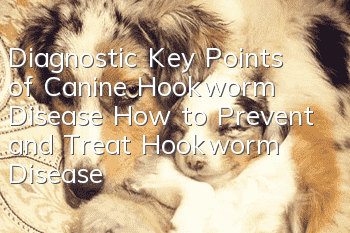Diagnostic Key Points of Canine Hookworm Disease How to Prevent and Treat Hookworm Disease

Pathogens of canine hookworm
The common pathogens that cause canine hookworm are Ancylostoma canis and Ancylostoma canis.
Canine hookworm is a small light yellowish white nematode with a head end slightly bent dorsally and a well-developed oral pouch. There are 3 canine teeth on each side of the ventral surface of the front edge of the oral pouch, and each tooth is curved inward in a hook shape. Male worms are 10 to 12 mm long, and female worms are 14 to 16 mm long. The two ends of Ancylostoma stenocephalus are slightly thinner and smaller than Ancylostoma canis. There is a half-moon-shaped cutting plate on each side of the ventral surface of the front edge of the mouth sac. Male worms are 5 to 8.5 mm long, and female worms are 7 to 10 mm long.
Hookworm eggs are excreted in the feces. Under suitable conditions, the larvae (baculovirus) hatch for 12 to 30 hours and degenerate into infective larvae (sheathed filariasis) after about 1 week. Dogs are commonly infected with oral cavity, skin and oral mucosa. After entering the host through the mouth, the larvae stay in the intestine, remove the cyst sheath, and gradually develop into adults. After entering the skin, the larvae burrow into peripheral blood vessels, migrate to the alveoli and trachea, bring sputum into the mouth, swallow and develop into adults in the small intestine. Canine hookworms can also be infected by the placenta and colostrum. The life cycle of hookworms is similar to hookworms, but oral infections are more common.
Key points for diagnosis of canine hookworm disease
(1) Clinical symptoms: In severe infection, the mucous membranes will be pale and emaciated, and the coat will be thick, dull, and easy to fall off. Loss of appetite, heterophilia, vomiting, digestive disorders, alternating episodes of diarrhea and constipation. The feces may be bloody or black, and in severe cases may be tar-like, with a rancid smell. If the larvae invade through the skin, the skin will become inflamed and itchy. Some limbs may be swollen and later ulcerated, or the corners of the mouth may be eroded. Puppies under 3 weeks old that are infected with hookworm in the womb or colostrum can cause severe anemia, leading to coma and death.
(2) Laboratory examination: The saturated salt water flotation method can be used to check the eggs in the feces for diagnosis.
Measures for the prevention and control of canine hookworm
(1) Deworming: The commercial preparation is 4.5% diiodonitrophenol solution, and the dose is 0.22 ml (10 mg) per kilogram of body weight for one subcutaneous injection. The deworming effect against various hookworms in dogs is close to 100%. This medicine is not effective against canine roundworms, whipworms, tapeworms and paragonimiasis. In addition, levopyrimidine, toluidine, and pyrantel can also be used to anthelmintic. For dosage and usage, please refer to Canine Ascariasis. Severe anemia requires symptomatic treatment, oral or injected iron-containing supplements or blood transfusions.
(2) Sanitation and disinfection: The kennel should be kept clean and dry, and feces should be cleaned up in time. The wooden parts of the cage house are ironed with boiling water, the iron parts or the ground are burned with a blowtorch, and the movable equipment can be moved outdoors to expose the insecticide eggs.
- Is it better for Dogo dogs to have their ears erect or cropped? A case of Dogo dog’s ear erection surgery will tell you
- What do dogs eat to protect their stomach? It is important to protect their stomach and treat gastrointestinal diseases in dogs.
- How to tell if your dog is fat? Is your dog overweight?
- Will your dog catch a cold if you blow the air conditioner? What should you do if your dog catches a cold if you blow the air conditioner?
- What should you pay attention to when your dog drinks water? Don’t be careless when it comes to your dog’s drinking water.
- The dog's mouth bites and shakes. Why does the dog's mouth occasionally shake and bite?
- How to cut a dog's hair? Do you know how to cut a dog's hair correctly?
- Can dogs eat raw eggs? Why can’t dogs eat egg whites?
- Common Dog Problems in Summer How to Deal with Different Dog Problems
- How to keep dogs away from skin diseases. If you do this, will you see if your dog will still be infected with skin diseases?



